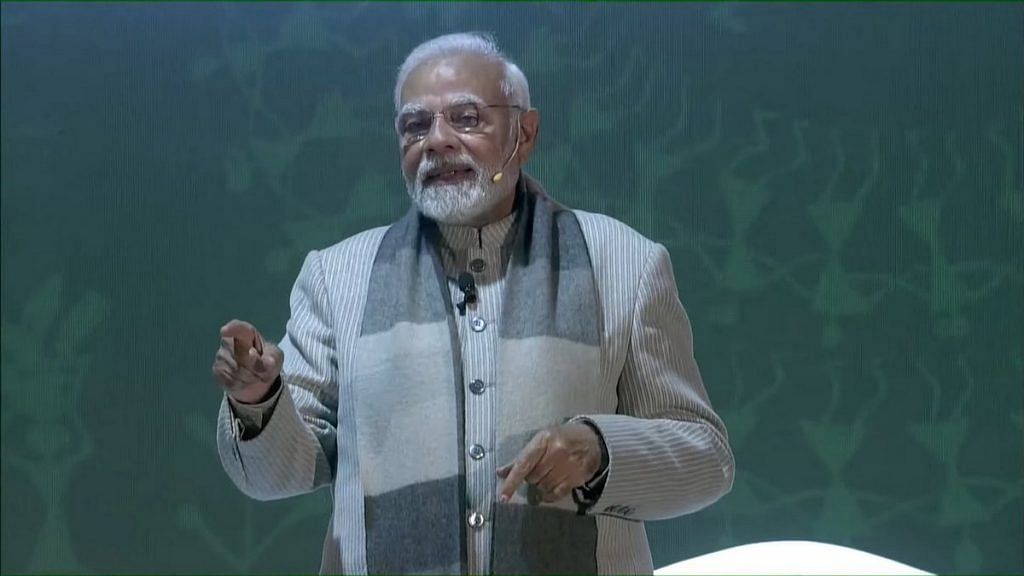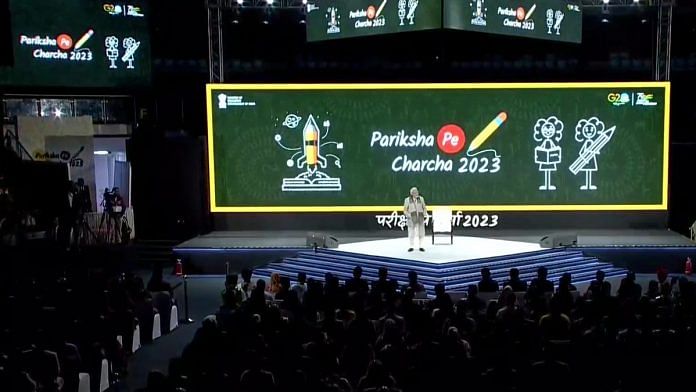New Delhi/Siddipet/Bengaluru/Mumbai/Lucknow: Prime Minister Narendra Modi’s annual pep talk session for students, Pariksha Pe Charcha, had some hits and a few misses this Friday. While some students said they gathered pearls of wisdom, others complained that they did not understand Hindi or that the content was not new. Some teachers also said their school didn’t have the resources to telecast the event.
This year, a record 38.8 lakh students registered for Pariksha Pe Charcha, which took place in Delhi’s Talkatora Stadium and was telecast live at schools across the country. At the event, the PM interacted live with students and answered questions about exam stress and other education-related issues.
But while the Ministry of Education (MoE), the event’s organising body, asked all schools and higher education institutions to show the event to their students, there were challenges for some.
For instance, students in Telangana and Karnataka told ThePrint that the PM was speaking in Hindi which they did not understand. Their teachers and classmates had to later translate the answers for them, they said.
In some instances, a resource crunch became a barrier. The MoE had told schools to make necessary arrangements in case they lacked infrastructure like electricity, TVs, and internet connections, but not all managed to do so.
For instance, a teacher at a school run by the Municipal Corporation of Delhi (MCD) said that they could not telecast the event for lack of a TV and internet. The teacher also noted that MCD schools operate only up to Class 5 and that the content might not be relevant for younger students.
Nevertheless, most schools tried to follow the directives in whichever way they could. In some cases, schools sent link to a recording of the event to phones of students. Other teachers said they planned to download recordings of the event on their personal devices and show students later. At a school in Bengaluru’s Hebbal, teachers used their own laptops to stream the event.
Also Read: Reading ability among children back to pre-2012 level due to pandemic, finds education survey
Hindi woes
In a tiny government school in Telangana’s Guggilla village in Siddipet district, more than half of the 46 students who attended the event virtually do not understand Hindi — the primary language in which the PM was answering questions. The strength of the school is around 60 students.
Headmaster Eppa Srinivas Reddy told ThePrint that the video of Prime Minister’s speech will be replayed in the school and that a Hindi teacher will translate it for the students.
“There are hardly any Hindi speakers in our district or town. So, expecting the kids to understand the language that the Prime Minister speaks is unfair. We have a Hindi teacher who will translate the speech and explain it to the students. But, such a gesture from the Prime Minister is very motivating for the students,” Reddy told ThePrint.

Some students who understand rudimentary Hindi, however, said they managed to pick up helpful nuggets from the PM’s talk and explained these to their classmates.
“From what I understood in the speech, I liked that the Prime Minister spoke on how to avoid social media platforms, how to stay focused, and to have a timetable. And I explained that to friends in my class,” said Rakesh Gollan, a Class 10 student.
Rakesh’s classmate D.Shyamala also understands some Hindi but cannot speak more than a few basic sentences. She couldn’t follow the entire interaction, but said she did appreciate a few points.
“The Prime Minister told us how it is not enough to just put in hard work, but that smart work is also necessary. The session was motivating for us. Some of my friends do not understand Hindi at all. So, I translated the minimum I understood. We are thankful to the PM for doing this to motivate us,” she said.
Schools in southern Karnataka also faced similar challenges. Teachers ThePrint spoke to said that they were translating PM’s answers for students.
“We interpreted most of the questions and answers to students for them to fully understand the programme,” H.K. Manjunath, a teacher from the Bengaluru Public School in Hebbal, told The Print.
‘Old content’ for some, fresh perspectives for others
According to the MoE, nearly 20 lakh questions come in from across the country for the PM. These questions were filtered by the National Council of Educational Research and Training (NCERT), and the PM answered selected queries that covered 11 common themes.
These broad topics included handling disappointment, preparations for exams, time management, working hard vs working smart, recognising one’s potential, handling criticism, and online addiction, among others.
Among other things, the PM advised students to “stay focused” on their goals and “do hard work smartly”. He also asked students to not crumble under pressure and to “take up the least interesting or most difficult subjects when the mind is fresh”.
However, teachers in some Delhi schools said off the record that these subjects were covered in the previous Pariksha Pe Charchas (the events started in 2018) and so they did not make the students watch the live event.
For instance, a teacher at a state government school in West Delhi said it did not make sense to make students watch similar content year after year.
“Every year, students ask questions related to stress and time management. We usually address these issues in the classroom itself and give them personalised solutions since we are familiar with their working patterns,” he said.
Echoing this sentiment, a high school student at a government school in south Delhi said that the event’s Q&As don’t add much value to what teachers tell students anyway.
Still, some students felt that the PM gave them a fresh perspective.
“Some of the points raised by PM Modi really interested me. His reference to mothers managing time at home intrigued me. It made me realise how we can look for examples within our homes to look for simple tricks and tips,” 17-year-old Class 12 student Ipshita Sahoo said, adding that she watched the telecast with rapt attention.
‘Told to dress well’
Students at a school in Mumbai said that their preliminary exams are to begin from Monday but they had to come to the school only because of the event. The school had sent a message on a WhatsApp group asking students to dress well as invigilating officers were supposed to visit at the time. However, those who could not come to the school for the event were given a link to watch it at home.
In the hall where students gathered to watch the event, there was keen interest for about the first 30 minutes but later they started getting restless and began talking amongst themselves.
Some, though, said they got some useful takeaways. A Class 10 student, Madhuri Verma, said that she used the phone a lot and wasted her time but now she would reduce her mobile use as the PM advised to do so.
Answering a question about digital addiction among students, the PM said that students should observe a “technology fast” in which they abstain from all their devices. He also said that every house should have a demarcated “technology-free zone”.
The Uttar Pradesh government, meanwhile, used the PM’s event as an opportunity to felicitate meritorious students. Ahead of the telecast, 1,698 students were honoured at the Sainik School in Lucknow. Chief Minister Yogi Adityanath also attended this event.
With inputs from Sharan Poovanna, Purva Chitnis, and Shikha Salaria
(Edited by Asavari Singh)
Also Read: Why Swayam portal’s a dampener for Modi govt’s online learning dream. 3 cr signed up, 4% finished



